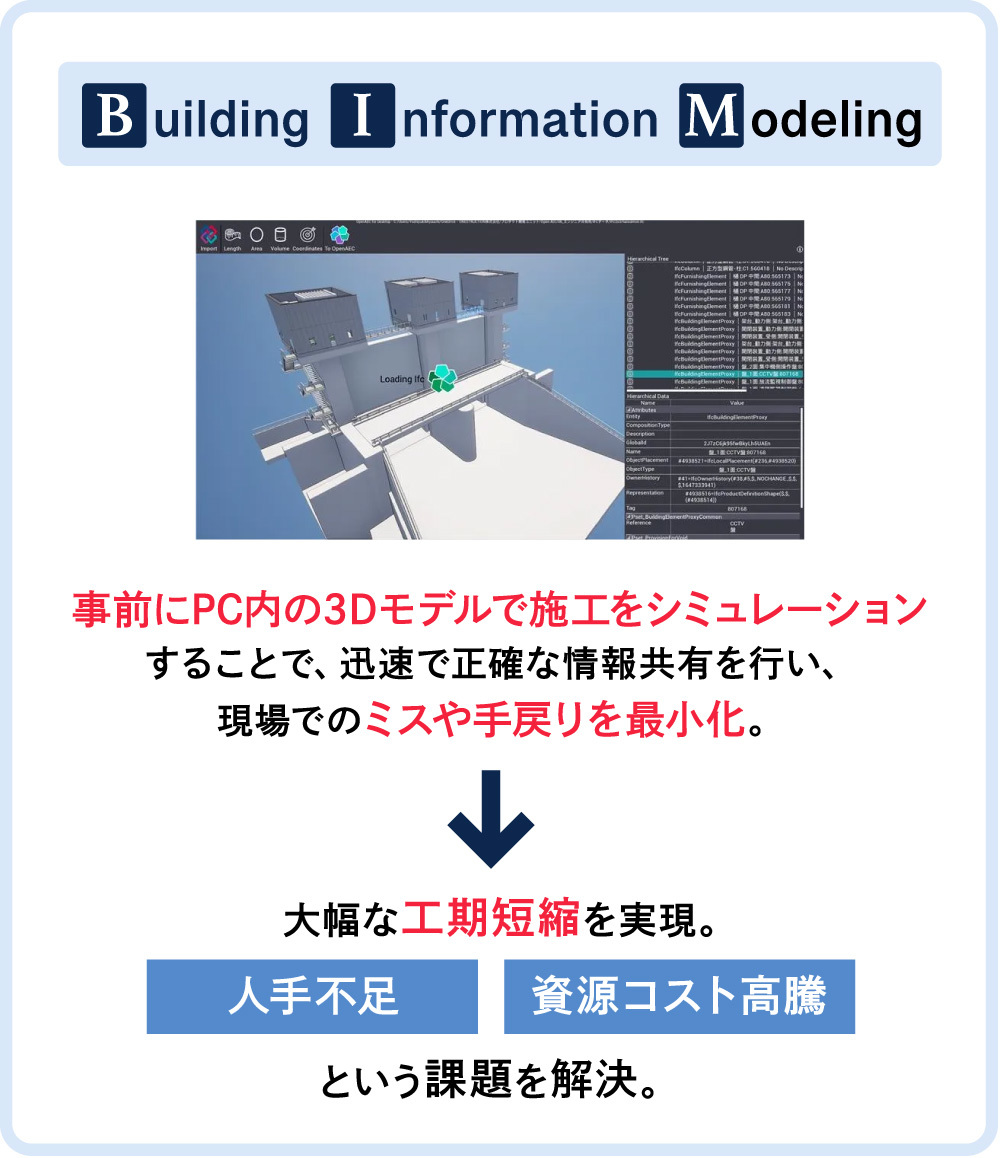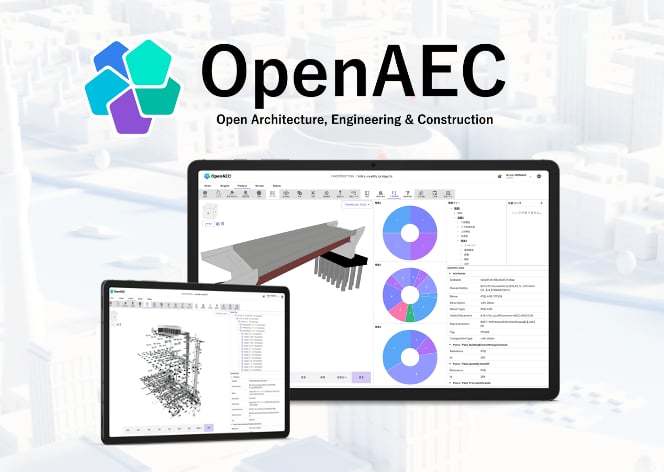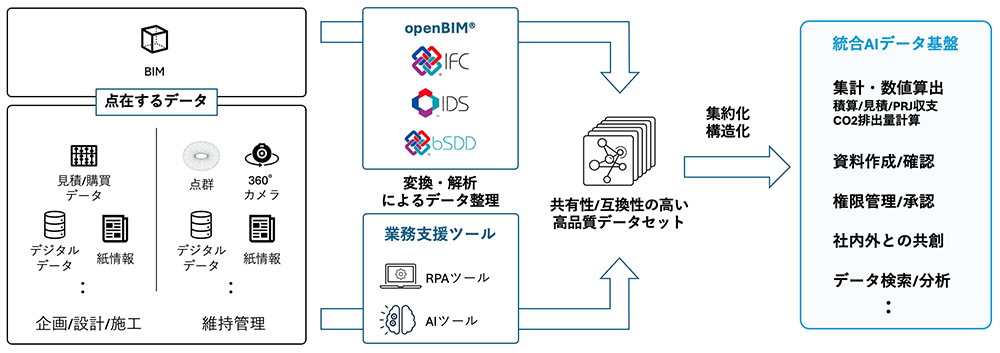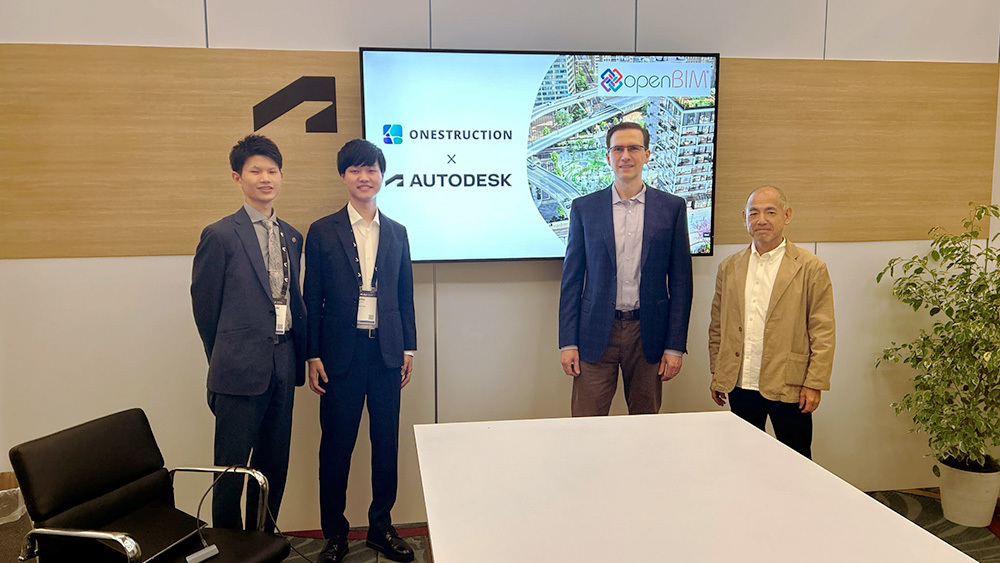From design to construction and operation—BIM (Building Information Modeling) integrates the entire construction industry with 3D data, redefining how construction is done. Globally, a battle for supremacy among major software companies has begun.
Amid this torrent, ONESTRUCTION Inc. (hereafter ONESTRUCTION), a Japanese startup challenging industry transformation with international standardization as its weapon, is drawing attention. What is its strategy for confronting the structural challenges of the construction industry head-on and elevating construction DX to a "management agenda"?
Dentsu Inc. Makoto Sasagawa spoke with ONE STRUCTION CEO Hiroo Nishioka, a young entrepreneur driven by the vision to "open all construction industry data."
What is BIM? The Impact of "Construction Digitization" on the Industry

OneStruction CEO Daio Nishioka
Sasagawa: I must admit, until meeting you a year and a half ago, I had never even heard the term "BIM."
Nishioka: I don't blame you. In fact, even within the construction industry, only a very small number of people truly understand and effectively utilize BIM.
The full name is "Building Information Modeling." It's a system that centrally manages all information related to construction—design, processes, costs, operations, and more—using a 3D model as its core.
Sasagawa: So, essentially... it's like a "database" for the construction industry?
Nishioka: Exactly. While database integration is commonplace in other industries, it hasn't advanced much in construction. However, in recent years, using BIM as a starting point, it's begun to progress rapidly.
Sasagawa: So, database integration in construction using BIM as the entry point? For example, what kinds of tools are people using?
Nishioka: Just as design fields have foundational tools like Photoshop and Illustrator, and business operations have tools like Salesforce, global tech giants like Autodesk in the US and Nemetschek in Germany are now central players in the BIM space, competing for dominance.
Sasagawa: BIM is also effective against the structural challenges currently facing the construction industry—like labor shortages and soaring material costs, right?

Nishioka: Yes. First, regarding the labor shortage. We're seeing a mass retirement of veteran craftsmen, creating a "knowledge vacuum." Even if they want to pass on their skills to younger workers, that know-how isn't formalized. Using BIM allows us to preserve the expertise of veterans as "data."
Sasagawa: That really helps me visualize it. Then there's the issue of material prices—construction costs have really skyrocketed in recent years, haven't they?
Nishioka: Exactly. But increasing the construction budget isn't easy. BIM allows for detailed simulations right from the design phase, significantly reducing material waste. Less waste means less pressure on profits—it creates that structure.
Sasagawa: I see. So the key is having data that's "connected" throughout the entire process: design → estimation → construction.
Nishioka: Exactly. The core value of BIM lies in simultaneously managing two things: "centralizing all construction data into a shared database" and "visualizing both 2D and 3D models." With traditional 2D drawings alone, the designer's intent often wasn't conveyed clearly. When design errors occurred, it frequently led to on-site rework like "This part is wrong, isn't it?" But with BIM, you can spot mistakes during the modeling process, and simply showing the BIM model instantly conveys the intent. The quality of communication is completely different.
Sasagawa: When I renovated my house, I couldn't understand the 2D drawings at all (laughs). Only after it was finished did I finally get it—oh, so that's how it's supposed to look.
Nishioka: Exactly (laughs). Misunderstandings among craftsmen on-site are drastically reduced with 3D models, which also shortens construction time. In fact, estimates from the Ministry of Land, Infrastructure, Transport and Tourism show that adopting BIM can potentially reduce construction time by up to 10%.
Sasagawa: That's huge. It means a year's worth of construction could finish in 11 months.
Nishioka: Exactly. And it doesn't stop there—it directly addresses the structural issue of labor shortages. By supporting on-site decision-making, coordination, and cost estimation, BIM increases productivity per worker. That's why I believe the significance of "digitizing construction data" is immense.
Sasagawa: In the construction industry, often called a 72 trillion yen industry... is it really becoming such fundamental infrastructure? Or rather, it already is, isn't it?
Nishioka: That said, adoption rates in Japan still aren't sufficient. Especially among small and medium-sized enterprises and in regional areas, many don't even know what BIM is, and it's common to hear, "Just make a 3D model for now." But precisely because of that, it's worth doing now. The opportunity to change the structure isn't always there.
Why BIM? — How a Farm Boy Awakened to Construction DX

Dentsu Inc., Makoto Sasagawa
Sasagawa: "A database shaping the future of construction"—that's what BIM is, isn't it? Next, tell us about your starting point, Mr. Nishioka, when you jumped into this world. You weren't in the construction industry from the beginning, right?
Nishioka: Not at all (laughs). I'm originally from Kyoto and attended a local agricultural high school. Back then, I was researching turfgrass—things like rooftop greening and slope greening. I never imagined in high school that I'd end up developing software right in the heart of the construction industry.
Sasagawa: Turf!? How does that connect to BIM?
Nishioka: Actually, someone from a super general contractor happened to take an interest in that turf research and supported it with funding. Because of that connection, I also got involved in the greening project for the super levee in Miyagi, one of the areas hit by the Great East Japan Earthquake. Even though I was just a high school student, I gained incredible field experience verifying greening activities and labor-saving maintenance methods in a disaster zone.
Sasagawa: What an incredible start to your career... A high school student working on super levees with support from a super general contractor.
Nishioka: That experience made me feel the sheer scale and complexity of the construction industry, but also its "real necessity"—the fact that it's genuinely needed. Honestly, though, back then I wanted to become a researcher and planned to continue studying agriculture in university.
Sasagawa: So what was the turning point that drew you into entrepreneurship?
Nishioka: It was a lecture I heard in high school by Mitsuru Izumo of Euglena. His words, "Technology only has meaning when it's implemented in society," struck me deeply. That's when I decided, "I don't want to be a researcher; I want to be the one delivering technology to society."
Sasagawa: So you went to Tottori University's Faculty of Agriculture?
Nishioka: Yes. Then, while in university, I participated in the "MAKERS UNIVERSITY" entrepreneurship support program run by the NPO ETIC. That experience dramatically heightened my ambition. Meeting student entrepreneurs from all over Japan, many of whom were aiming to start businesses in Web3 or AI at the time, made me certain: "I want to compete in legacy industries."
Sasagawa: So that's where the idea of bringing tech into primary and secondary industries like agriculture and construction was born.
Nishioka: That's right. But back then, I couldn't do anything. I came up with a few business ideas, like a farm equipment sharing service, but I had neither a product nor a team, and I completely failed. So, I decided to get a proper job first. I got a job offer from Recruit and thought, "I'll hone the fundamentals and skills needed as a working professional." But before graduation, I had a life-changing encounter. Meeting Yoshikazu Miyauchi, a senior from graduate school who is now our CTO, sparked a strong interest in the construction industry.
Sasagawa: That's where BIM comes in!
Nishioka: Exactly. The more I researched, the more I realized agriculture and construction share massive parallels. Labor shortages, personalized skills, inefficient sites, slow IT adoption—the structural challenges were identical. There were twists and turns, but the moment I thought, "BIM might actually transform the structure itself," my path became clear. Before joining Recruit, I decided to start a company—that's OneStructure.
Sasagawa: Trying to change the construction industry as a side hustle? That's crazy ambitious (laughs).
Nishioka: For me, there was no distinction between side hustle and main job. Of course, it was incredibly busy, but the skills and colleagues I gained at Recruit became invaluable assets for me as an entrepreneur. I got to handle everything from product development to design and growth.
Sasagawa: Your career path from "lawns to BIM" has no wasted steps... Your origins are clearly connected to your present.
How to Compete Globally? The Reality of OpenAEC and "Standardization"

Sasagawa: Hearing all this , I clearly understand how BIM could become the "common language of construction." But I want to know more about how OneStruction actually turns that into a business—the specifics of how you fight.
Nishioka: We started by offering contract services to construction companies that only used 2D drawings, creating and delivering BIM 3D data on their behalf. By immersing ourselves on-site, we were determined to learn: "How is BIM actually used in this industry?" and "What are the bottlenecks?"
Sasagawa: More like "industry infiltration" than research.
Nishioka: The biggest revelation was the reality that "while BIM is implemented, it's used in a fragmented way within companies." For example, design uses Revit (Autodesk's BIM software) and Excel, quantity surveying uses domestic tools, and construction management uses yet another domestic software. There's also significant division between the architecture, civil engineering, and MEP disciplines. Consequently, information gets siloed, making collaboration cumbersome.
Sasagawa: I see... So it's the pitfall of having implemented BIM, but the data isn't connected.
Nishioka: That's why we decided to create a product that acts as a "translation hub" between different software. That's our in-house developed "OpenAEC". "AEC" stands for Architecture, Engineering, Construction. In other words, it's a foundation designed to connect all aspects of the construction industry—design, engineering, and construction—in a cross-functional way.


And the key enabling this "translation" is the international standard format, IFC (Industry Foundation Classes). Utilizing this standard makes data interoperability possible between different BIM software.

ONESTRUCTION's BIM software "OpenAEC" is developed in accordance with international standards and is currently used in 54 countries. With this product, ONESTRUCTION became the first Japanese company selected as a finalist for the international "openBIM Awards 2024."
Sasagawa: The organization that established IFC is buildingSMART International (bSI), right? Isn't it quite unusual for a startup to participate there?
Nishioka: It certainly is. We're the only startup from Japan. But if you're not at the table where the rules are set, you can't compete globally with your product. That's why we're not just joining; we're actively involved in the working groups.
Sasagawa: So standardization is a battle.
Nishioka: Exactly. Needless to say, standardization is the trend for software, not just BIM. Unifying common rules globally enables cross-border coordination and collaboration.
Europe is at the center of this standardization effort. While America approaches it through product strength, Europe focuses on creating common standards and building an economic sphere protected by those standards. That's why OneStructure is committed to European standardization bodies.
Sasagawa: What benefits does committing to standardization bring?
Nishioka: In reality, the commitment to standardization itself does not generate short-term revenue. However, for European companies, controlling international standards is essential. Those who control the rules control the industry. And I believe it's precisely because we commit to standardization that OpenAEC is now used in 54 countries worldwide, that we were selected as a finalist in the Technology category of the openBIM Awards, and that we received the Startup Encouragement Award at the Infrastructure DX Awards.
Sasagawa: I see. And then there's that business partnership with Autodesk. That had a huge impact.
Nishioka: It was a dream come true. Not only could we sell their products as an official distributor, but we became an integral part of Autodesk's ecosystem as a collaboration partner. That fundamentally changed the level of trust we received from the industry.
Sasagawa: What is the significance of OneStructure creating domestic BIM software like OpenAEC?
Nishioka: One is that, in these times of what's called an IT trade deficit, Japanese software can actually sell well globally. It's about earning foreign currency. OneStructure is firmly competing here. Another significance is feeding back the insights gained from participating in standardization and specification development back into Japan's construction industry.
Sasagawa: Listening to you, I realize OneStructure isn't just saying, "Use our software."
Nishioka: Exactly, we place great importance on that. The ideal state is for architects, civil engineers, and MEP engineers to continue using the software they're familiar with. However, without standardizing the "data," we can't optimize workflows. That's precisely why we want to be the "bridge."
Sasagawa: It feels very Japanese, like the philosophy of "harmony through cooperation" (laughs).
Nishioka: Rather than the kind of "lock-in" with proprietary products you see overseas, we envision sites operating freely while being connected through data as a whole. That model feels suited to Japan's construction industry. We want to steer global standardization in that direction.
Positioning BIM within management strategy, not just superficial digital tool adoption
Sasagawa: BIM is a broad technology, but initially, companies probably won't roll it out company-wide all at once. Instead, most will likely start with PoC-style trials by department or project, right?
Nishioka: Practically speaking, yes. However, when supporting company implementations, I often emphasize that positioning BIM as part of the "business strategy" and implementing it company-wide undoubtedly yields greater results. Data only truly demonstrates its value when combined with all other relevant data.
In other words, it shouldn't stop at simply converting drawings to 3D. For example, linking estimation data to BIM can automate cost estimation. There's no reason not to make a management-level decision on this kind of "data integration" that promises multiple benefits.
Sasagawa: When BIM changes how work is done on-site, it also transforms the company's vision and the value of its employees. That's what true DX is all about.
Nishioka: Exactly. DX isn't just about implementing superficial IT tools. If we're going to do this, I want BIM on the management agenda. However, what we possess is technology and on-site experience. But DX doesn't advance with technology alone. For these company-wide proposals, I'm counting on our collaboration with Dentsu Inc.
Sasagawa: To elevate BIM onto the management agenda, having a seat at the table with executives is essential, right? Dentsu Inc. has work where we discuss fundamental corporate challenges and goal setting with executives, like purpose formulation and MVV (Mission, Vision, Values). OneStructure creates BIM's "common language," and Dentsu Inc. translates that language into "management terms" to spread it throughout the company. It would be great if we could shape that kind of partnership together.
Nishioka: For the construction industry to truly transform, I believe we need a structure that simultaneously communicates to executives, the field, and society as a whole.
Sasagawa: This time really brought home that BIM, the digital transformation of construction, is both a management agenda and an industry agenda. Thank you for today.


















